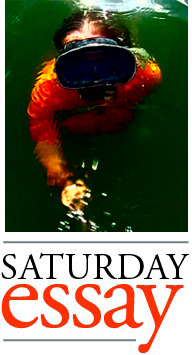
A document hoarder, Svenson was practically the state’s analog back-up brain for decades, and its conscience.
He was a popular history professor at UMD from 1973-2002. However, he tussled with the university over the legitimacy of his sources. Then they disavowed his work altogether when issues arose about his statistical analyses. Under pressure, he took early retirement, but sued the university for defamation. He lost.
Svenson went on to self-publish books, monographs, and articles, but struggled to find a paying audience. His most important work was produced during this period. Being his friend enabled my access to his research and unpublished manuscripts.
Svenson at UMD, 1980
I first met Peter S. Svenson on a tour of Fremont in 2003 as we fished its marshy edge in hip-waders, talking about Minnesota history. Many people found him contrarian, but I didn’t. It was the beginning of a lifelong friendship benefitting my own independent research.
He cracked the case of Lake Inferior, until then a lost reference in the moldy journals of Sir Duluth. Thanks to his diligence, the timeline of von Bitter’s historic forgotten dives in the underground “lake beneath the lake” was established. Svenson obtained Professor Marrow’s depositions and police interviews, including his delirious exhortations to forget the Lake Inferior Diving Disaster. Marrow’s daughters had died 12 years previously in the SuperiorLab-Marquette disaster, which Svenson archived with his usual flair for obtaining documents and transcripts no one else knew existed.
Svenson provided me with documentation about the construction, launch, and legal history of the Lake Superior ghost ship Janus, and also of the conspiracy theories surrounding the vessel and its disappearance. Subsequently I viewed records at the Karpeles document museum.
It was Svenson who sleuthed a path to Duluth’s peerless role in the Civil War, assembling the history of Buckminster Wilde and the Hillside Irregulars. Svenson discovered Wilde’s fake death certificate, which shed light on the Walt Whitman journals, the Pinkerton files, and the Jay Cooke archives, proving Duluth was built with the so-called “lost Confederate gold.” This discovery alone warrants a bust in City Hall, if not the State Capitol. I am happy to spearhead the project.
Svenson funneled me documents about the victims of the Lake Superior sea monster, plucking the lethal pattern from data hidden or suppressed in first-hand testimonies.
In 2011 Svenson wrote a monograph, “The Forgotten Duluth Painter, Edward Alexander Congdon.” Years later on Halloween he granted me the first in a series of transformative interviews about his research into the Congdon estate and Edward Alexander’s extravagant life. Svenson possessed samples of the charred baby teeth from ancient Phoenicia which he showed me after one too many after-dinner cocktails, in a brass box of inlaid agate. Among his prodigious collection of Minnesota art and historical treasures, he owned a single painting by the master, which he never let me see. But he willed it to me. Since his death I have locked it in a closet, and I blame it for my rapid psychological deterioration.
Svenson, a disclaimed Dylanologist, pioneered study of the early Bob Dylan-Minnesota mafia connections.
He authored the book The First Time Germany Invaded Duluth, Minnesota in 2012, based on his 1995 interview transcript, Deathbed Interview with pilot George Enger III, Duluth’s WWI Fighting Ace.
He wrote articles for local newsweeklies and street sheets, including “The Art Riot: What Do We Know?” in issue #763 of the Northland Reader, Nov. 21, 2012. No other local writer engaged with the incident’s importance.
In 2018 he sniffed out a cache of hitherto unsuspected Shackleton letters.
Just a few months ago he gave me notes toward his next book, Duluth’s Untold World War II Tales. Based on old news clippings, he’d gotten as far as a profile of the amateur sub-hunter known as Duluth’s Granny.
Then I lost contact with him.
I discovered his body at his home last week, crushed beneath collapsed walls of stacked books, files, manuscripts, loose papers, magazines, journals, and newsweeklies which smothered him, burying him alive under the weight of history, including many copies of his own unsold books.
Conspiracy theories of murder spread across the internet. Even I have been named as a possible suspect in these bad-faith rumor mills.
Foul play is out of the question. I was there when they pulled Svenson’s body free from the tsunami of information which drowned him. I saw with my own eyes that he had caused his own death. His hand still clutched the spine of a book, a book I shall not name, for perhaps there is not enough mystery in the world. He’d pulled it from the bottom of an edifice of knowledge along the wall at the top of the stairs. The stairwell, itself choked with teetering columns of encyclopedias and academic journals, became a rushing torrent of books, files, and magazines. He rode the scree until the structurally unsound stacks of hardcover volumes on the landing toppled like cracked cathedrals. The avalanche swallowed him, depositing him in his foyer.
His outstretched hand alone was visible as I arrived through the kitchen some days later. He had kept his grip on the mystery book, and died holding it out like a message. Okay I’ll tell you: it wasn’t some tome of scientific anomalies. It wasn’t Edward Alexander Congdon’s missing grimoire. It wasn’t an old almanac, or a book of maps. It wasn’t a folder of transcripts. It wasn’t a binder of clippings.
It was a photo album, of his own baby photos, that his mom made for him when he was four.
It is with great respect and humility that I honor this true Minnesota legend.
All who knew or met him are invited to leave remembrances in the comments below.
Let the recriminations begin.
An index of Jim Richardson’s essays here.